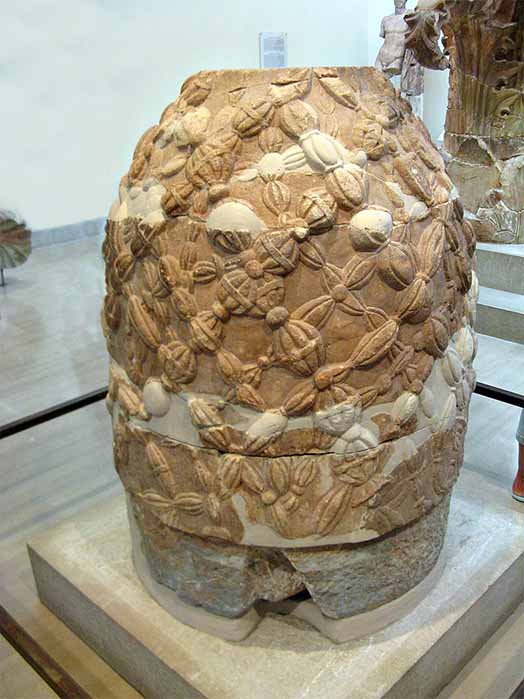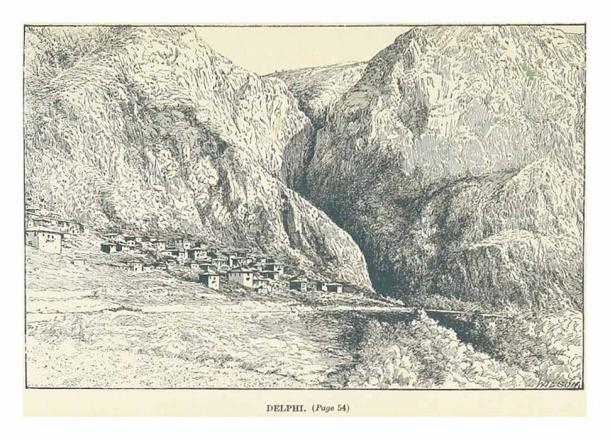The ancient Greek city of Delphi, located on the slopes of Mount Parnassus, was home to the main Temple of Apollo and the renowned Oracle of Delphi . According to legend, the site was identified by Zeus, the King of the Gods, who sought to find the epicentre of the earth goddess Gaia, or his ‘Grandmother Earth’. Zeus sent two eagles flying from the eastern and western extremities of the earth and they crossed paths over Delphi. Zeus marked the spot with a large, egg-shaped stone called the omphalos, which means “navel” and the ancient Greeks revered this site as the centre of the world. The site had since been recognized as a UNESCO World Heritage Site due to its immense influence in the ancient world.

The Omphalos stone in the Delphi Museum ( Юкатан /CC BY-SA 3.0 )
Homeric literature often references the sacred Temple of Apollo. In the Iliad, Achilles refused to accept Agamemnon’s offer to reconcile even if it included all the riches held within the “ rocky Pytho’s hallowed stone floor ”. Achilles was referring to the treasures at Delphi, of course, and as it happens an excavation at Delphi has yielded an increasing number of artifacts such as pottery, bronze, and tripod dedications since the latter quarter of the eighth century BC. The variety of artifacts, the presence of prominent dedications, as well as the huge quantity of rich objects, lends support to Achilles’ claim. In the Odyssey, Agamemnon crosses the same “stone floor” to receive a prophecy from Apollo’s Oracle of Delphi. In Theogony, Hesiod also refers to Pytho “ in the hollows of Parnassus ”. This implies that the earliest known date of the oracle’s existence is the eighth century BC, the probable date of composition of the Homeric works.
Even by the 19th century, Delphi was still frequently visited by many renowned artists who proceeded to create works based on the site. These works included diaries, sketches, and views of the region, as well as depictions of coins. These illustrations typically reflected the spirit of romanticism, as seen in the drawings of German archaeologist Otto Magnus von Stackelberg. Notable figures such as the poet Lord Byron, who was accompanied by poet and painter William Haygarth, also visited Delphi and wrote about their experiences.

Site of Delphi. Vulva of the Earth, Gaia, with the two Phaedriades above, resembling her breasts. In this drawing the village of Castro still occupies the site ( Public Domain )
Apollo Seizes Delphi from Gaia
A seventh-century BC Homeric Hymn to Apollo , connects Apollo to the site through his epithet Δελφίνιος, (Delphinios, “the Delphinian”), and relates the myth of Apollo’s journey in search of a location for his oracle.
Like this Preview and want to read on? You can! JOIN US THERE ( with easy, instant access ) and see what you’re missing!! All Premium articles are available in full, with immediate access.
For the price of a cup of coffee, you get this and all the other great benefits at Ancient Origins Premium. And – each time you support AO Premium, you support independent thought and writing.
Martini Fisher is an Ancient Historian and author of many books, including “Horatio’s World” / Check out MartiniFisher.com
Top Image : Speculative illustration of ancient Delphi by French architect Albert Tournaire (1894) ( Public Domain)
By: Martini Fisher
Views: 0
 RSS Feed
RSS Feed















 March 2nd, 2023
March 2nd, 2023  Awake Goy
Awake Goy  Posted in
Posted in  Tags:
Tags: 
















